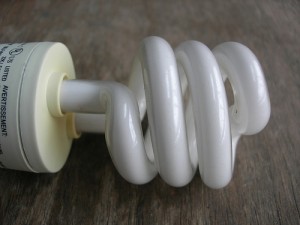by Alison Wiley
My diamond-cut household’s monthly electricity use is about half the national average. Besides saving more than $450/year, we’re lowering our carbon footprint because even here in Oregon, coal-burning fuels about 36% of our electricity. And our house is happy, not deprived (diamond-cut = chiseling our consumption down to the core of happiness).
Work first on your usage of everything involved in heating and cooling, since that’s where the bulk of energy gets used. In rough order of importance, starting with the most powerful changes:
- Keep the refrigerator and freezer well-sealed, closed as much as possible - and full. Put bottles of water in any empty nooks. They act like batteries helping to preserve the temperature.
- Adjust the thermostat in your electric water heater downward. Scalding-hot water wastes energy and is also dangerous.
- Put aerators on your shower-heads and faucets. These wonderful, inexpensive gizmos conserve hot water beautifully.
- Wash clothes in cold water, and only wash full loads.
- Use a clothesline (indoor or outdoor) instead of the dryer. Dryers are energy hogs. Our clothesline is in the basement. Hanging things up takes a bit more time, but in effect you’re getting paid for your time. Also, you’ve got 168 hours every week.
- If you replace your old refrigerator with an Energy Star model, get rid of the old one. Don’t just relocate it into your basement or garage to store beer, etc. – a second refrigerator increases your energy use dramaticallly, despite one being Energy Star.
- Replace your incandescent (conventional) light-bulbs with compact fluorescents (CFL’s, the coiled type pictured above). CFL’s use 75% less energy. You can get used to their taking a few seconds to reach full brightness.
- If a big-screen TV is important to you, choose an LCD instead of plasma. LCD uses half the energy. (We have a normal TV in the basement that gets no channels – we just rent movies occasionally. OK, call us weird.)
- Use the microwave for anything that will fit into it instead of the conventional oven.
- Unplug things after using them, i.e. coffee-maker, stereo, space-heater, TV, cell-phone and IPod chargers. Those tiny glowing lights signify an energy-sucking vampire load. Power-strips make this habit easier.
More resources: Lower My Electricity Bill;
Top Ten Tips For Saving Energy
photo courtesy of Dano



 Subscribe
Subscribe
Wonderful suggestions, we employ many of them.!
We unplug those energy vampires when we’re not using them. We use a toaster oven often, instead of the big oven. We wrapped our hot water heater in insulation (we’re saving for a new tankless one). The new tv is LCD, and the fridge is the highest energy efficient available on the market. We’ve gone completely CFL. Our one luxury is the hot tub (I have fibromyalgia and the hot tub is better than any medication) - but we lowered the temp and reduced the cycling/filtering time. We blew a thick layer of loose insulation into our attic. We also moved 1 hr north of Portland to a smaller town, and downsized into a small, one level 900 sq foot home that has fantastic energy efficient windows. We LOVE living in a small home! Altogether, our efforts and changes have reduced our monthly electric use by 40%. And this county only uses 2% of coal for its energy!
We also conserve water - I keep a gallon jug at the sink and catch every drop of cold water as I wait for the warm. I capture at least 1-1.5 gallons every day, great for the dog bowl, my many plants, and I dump excess into my rainbarrels. We have 4 rain barrels that we use for our large organic veggie garden ( we donate fresh produce to the local foodbank, and we garden-share with our neighbors - sharing labor and the fruits of it).
I also telecommute, so I often do not have to drive for days at a time. Hubby purchased on old, small ’78 Toyata pick up that gets incredible gas mileage, and he keeps it purring like a kitten. When convenient & the weather cooperates, we ride our bikes instead of drive.
There are SO many things one can do to reduce one’s carbon footprint, and to conserve, and to reduce monthly financial output. I’m hopeful that the green revolution will now greatly expand beyond the progressive PNW. I feel very optimistic about it!
LOVE your blog, btw, though you are so much more enlightened than I. Keep it up & keep enjoying life, you are an inspiration!
xo
dTrav001 // Jan 31, 2009 at 11:23 am
Deb: you, I’m sure, will be pleased to note a recent seminar I attended, a grad student commited to reducing his electric load by 50%. He accomplished over a third of his total goal just with powerstrips on phantom loads … a 17% total savings. He gots his from the dump, but be sure to look for the UL seal, and don’t use those without.
Deb: your right on with unplugging things after using them.
My wife thinks I’m crazy from running around like a mad man unplugging things every night, and unplugging mine and her cell-phone chargers when I leave 3 hours before her in the morning.
The glowing lights do add up. We have saved an average of about $40-50 / month by simply unplugging.
Hey, Alison! I just stopped by here for the first time in too long, and wanted to toss in some thoughts about saving electrons.
Insulating the water heater is definitely a good and very simple step, but don’t stop there. You can buy these foam tubes that insulate your exposed hot water pipes. I insulated our tank and pipes, and our water got noticeably hotter, so I was able to turn the thermostat down even more. (Think about your hot water pipes-long, copper tubes that carry hot liquid-they’re nothing but a long, stretched out radiator.)
People adjust very quickly to flipping the switch on a power strip, and the savings add up. Also, don’t forget that the savings go beyond CO2. You’re putting less of other pollutants into the air, and also consuming less water to cool thermoelectric plants. That last one is astonishingly large-cooling power plants accounts for about the same water withdrawal in the US as agriculture.
Hi what is item that you put on your faucet to save money because of savings on heat? How does it work?
I enjoy the information and reminder of how easy it is to save and how much we don’t even stop to think about.
We all really need to take action.